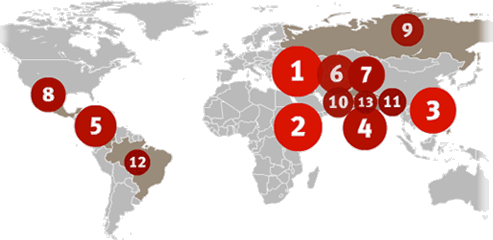Criminal groups exerted extraordinary pressure on the press as they extended their control over virtually every sector of society. Journalists were killed or disappeared, media outlets were bombed and threatened. Pervasive self-censorship was a devastating consequence of this environment. In an information vacuum, journalists and citizens increasingly used social media to inform their communities. The murder of a Nuevo Laredo reporter was the first case documented by CPJ worldwide in which a person was killed in direct relation to reporting done on social media. At least three journalists were granted political asylum in the United States and Canada, and several others sought refuge in other countries. Several major news organizations agreed on a professional code in which they set protocols for journalists at risk and pledged not to be propaganda tools for criminals. But President Felipe Calderón Hinojosa’s administration failed to implement effective reforms. Despite efforts to rejuvenate the office of the special prosecutor for crimes against free expression, anti-press violence went virtually unpunished. The government’s new journalist-protection program was widely seen as ineffective. And while the Chamber of Deputies passed a bill to federalize anti-press crimes, the legislation remained pending in late year.
Mexico
» Violence continues unchecked as administration fails in reform efforts.
» Murder is first worldwide in retaliation for reporting done on social media.
Criminal groups exerted extraordinary pressure on the press as they extended their control over virtually every sector of society. Journalists were killed or disappeared, media outlets were bombed and threatened. Pervasive self- censorship was a devastating consequence of this environment. In an information vacuum, journalists and citizens increasingly used social media to inform their communities. The murder of a Nuevo Laredo reporter was the first case documented by CPJ worldwide in which a person was killed in direct relation to reporting done on social media. At least three journalists were granted political asylum in the United States and Canada, and several others sought refuge in other countries. Several major news organizations agreed on a professional code in which they set protocols for journalists at risk and pledged not to be propaganda tools for criminals. But President Felipe Calderón Hinojosa’s administration failed to implement effective reforms. Despite efforts to rejuvenate the office of the special prosecutor for crimes against free expression, anti-press violence went virtually unpunished. The government’s new journalist-protection program was widely seen as ineffective. And while the Chamber of Deputies passed a bill to federalize anti-press crimes, the legislation remained pending in late year.
Analysis: Calderón Fails, and the Mexican Press Is Dying
The Mexican president promised to protect a besieged press corps with a federal protection program, a special prosecutor, and new legislation making anti-press violence a federal crime. But Felipe Calderón Hinojosa has failed at nearly every turn. Analysis by Mike O’Connor
-
3
Murders in 2011, motive confirmed -
2
Missing in 2011 -
0
Murder convictions by special prosecutor -
8th
Impunity Index rating -
8
Protected in government program
Maria Elizabeth Macías Castro, Luis Emanuel Ruiz Carrillo, and Noel López Olguín were killed in direct retaliation for their reporting, CPJ research found. Four other journalists were murdered in unclear circumstances. CPJ is investigating to determine if the motives were work-related.
Editor Marco Antonio López Ortiz was abducted in Acapulco in June, and police reporter Manuel Gabriel Fonseca Hernández went missing in Acayucán in September. Mexico has the highest number of missing journalists in the world over time.
Missing journalists in Mexico over time:
The office of the special prosecutor for crimes against freedom of expression was restructured in 2010 and placed in the hands of a new administrator, Gustavo Salas Chávez, in an effort to improve its record of ineffectiveness. Nonetheless, the new office had no immediate success in prosecuting journalist murders.
103
Total number of cases, most involving minor issues.11
Cases of murders or disappearances.7
Investigators assigned to the office.CPJ's Impunity Index found that Mexico is among the world's worst nations in combating deadly anti-press violence, with at least 13 unsolved murders over the past decade.

| 1. Iraq 2. Somalia 3. Philippines 4. Sri Lanka | 5. Colombia 6. Afghanistan 7. Nepal 8. Mexico | 9. Russia 10. Pakistan 11. Bangladesh 12. Brazil | 13. India |
The administration's new protection program for journalists under threat was widely seen as ineffectual and beset by bureaucratic rivalries. Only eight journalists were provided help by October 2011, and most said the protection was of little value.
Breakdown of the program:
Hundreds: Projected enrollment in the program.
8: Journalists enrolled.
5: Enrolled journalists who said the protection was ineffectual.
11 million pesos (US$840,000): First-year budget for the protection program, according to official figures.
